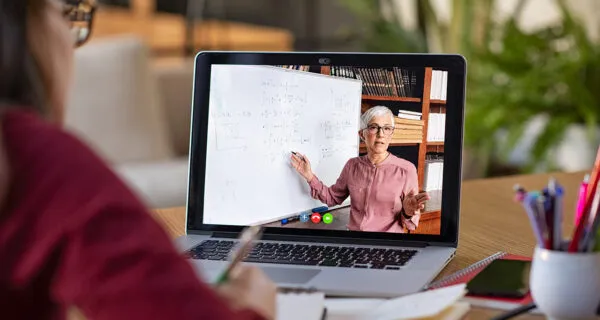BBSREACT / ARTICLES
Covid-19 and organizational change: the case of educational institutions
Because of the Covid-19 pandemic, in just a few days entire school communities in different countries in the world had to try a new type of teaching, completely digital, and quickly learn to use platforms and tools available online to manage the classes.
The unavoidable target was not to interrupt the educational-teaching dialogue between teachers and students, trying not to waste the motivation to learn. Before Covid-19, the issues connected to the use of new technologies were considered mainly for face-to-face teaching, were related to many teachers’ limited aptitude and poor technical ability to use the devices. With the suspension of face-to-face teaching activities and the introduction of remote teaching as the daily method or learning/teaching, new criticalities have emerged, but also new and extraordinary opportunities to rethink the way of doing and of “being” school.
What happened between the beginning of March and June 2020 shall have to be analyzed in depth, because to date we still have no evidence to get to reasoned conclusions on what will most likely become a paradigmatic case of crisis management and strategic change for many organizations, first and foremost the educational institutions like schools and universities. It is undeniable that with such an extraordinary acceleration, the enormous potential that an aware use of digital devices can initiate, to increase teaching effectiveness, has become apparent. In a sort of self-apprenticeship, teachers capitalized on a rich repertoire, from a purely technical point of view, that in the future they will have to learn to enhance intentionally, to test a more attractive and motivating teaching methodology for students and, most of all, more in line with their cognitive style and behaviors.
A survey conducted by Autorità Agcom (Italian authority for the guarantees in communications) on the effects of the coronavirus pandemic, shows that 25 Italian students out of 100 have experienced speed connectivity problems, 19 out of 100 reported that not the entire class took part in remote lessons, almost 10 out of 100 lamented not having suitable devices, but most of all 12.7% of Italian students could not avail themselves of the remote teaching activities. According to the Agcom report, the period of the coronavirus emergency was a catalyst of deficits and inequalities already existing, that will “exacerbate in the near future”. The widening of social inequalities mainly hit certain categories of students:
- children and youth with special educational needs, with specific learning difficulties or with attention deficit, who require a careful and responsible care in setting up dedicated teaching activities, which in the human relationship with teachers and schoolmates becomes effective in a social dimension of learning;
- younger students, that is kindergarten, primary and junior high school pupils, who have not got support at home and help from a competent adult, suffered more for the negative effects of remote learning, because of the cognitive limits linked to their age (limited autonomy, concentration difficulties, etc.);
- students who, at home, do not have a computer or a tablet and could not obtain any, with a free of charge loan for use from the school, were literally left out of remote learning. According to ISTAT (Italian National Institute of Statistics) data on space at home and the availability of computers for children and youth, in 2018-2019 the situation described above concerned mainly students living in the South of Italy, with a percentage nearing 20%;
- students who live in overcrowded dwellings (41.9% of minors according to ISTAT data) during remote teaching activities have experienced difficulties finding a space where to study and more difficulties of access to networks and digital devices.
Covid-19 increased social inequalities and brought to the fore the big differences that exist among territorial educational systems, among schools and among teachers in the same school. Organizationally, the pandemic is the example of an emergency situation of exceptional gravity that required a strategic discontinuity and the need to manage change on a collective scale.
During the pandemic, the already weak links of the school organization necessitated an extensive work of coordination to avoid drifting towards a possible organizational anarchy. Headmasters who have been able to develop, in their schools, the middle management could count on the precious contribution of collaborators, class coordinators, department coordinators, persons in charge of the digital development plan, safety managers and many other teachers committed to weave the fabric of a professional community.
Aspects such as the Headmaster’s teaching leadership ability, the presence of a distributed leadership, the teachers’ collaborative attitude, the propensity to adapt, the sense of community, showed all their relevance in determining the type of response that schools were able to provide to the emergency. These schools were able to intercept the emerging issues and to adapt to change more quickly and effectively than other schools with a very high reputation, but blocked by spontaneous behaviors, by teachers’ inertia, even very experienced and competent ones, unable though to question themselves and to learn rapidly new ways and methods to manage the class, reinterpreting their role with remote teaching.
What lessons can we learn for the future? We believe the relevant aspect is not simply whether before the Covid-19 emergency individual teachers had already gained remote teaching experiences or whether they were suitably equipped with advanced digital skills. We know thanks to the recent Talis (2019) survey that Italian teachers have training needs on the new digital technologies that are higher than those of the other OECD teachers. Nonetheless, the issue of digital innovation cannot be considered separately from the innovation of contents, teaching methodologies and class management dynamics. Transferring teaching from classrooms to multimedia platforms requires new skills, which are not strictly only digital ones, but ones that more deeply rely on the ability to use technologies in a proficient way to innovate teaching, customizing teaching-learning processes, promoting the interaction among students, supporting their independent and cooperative work.
Indeed, digital innovation is essentially innovation of the learning environments and this entails a shared and flexible educational view, which, leveraging on a self-assessment approach, can promote development dynamically, in order to meet ever new and emerging needs. Therefore, the ability of schools to tackle and mitigate the social inequalities of remote learning depended in the first place on the sense of community and the collaborative culture involving teachers, students and families, all authentically co-protagonists of that educational alliance necessary for the full implementation of an integrated educational project. A school that is prepared to manage remote teaching is a school that was able to develop, before the Covid-19 emergency, that set of personal, interpersonal, and organizational abilities that characterize learning professional communities.
The humbleness of teachers to rethink themselves as professionals, the unconditional commitment, the sense of responsibility, the ability to instill hope in their students, are the qualities of those Masters that also characterize teachers resilient to Covid-19. Nonetheless, the judgment on the resilience of the school as organization entails a different interpretation. Resilient organizations are the result of the investment their headmasters were able to make over the years, systematically but most of all systemically, building professional communities which did not stop learning during a terrible health emergency; that could leverage on teachers who constantly try new things through the research-action of different and better ways of doing things; they assess what works and what deserves a review in their professional practice; they reflect on increasingly innovative and effective approaches and methodologies to foster their students’ learning motivation, and they take on the individual and collective responsibility for their student’s results; finally they support students to face and overcome together the difficulties they encounter.
In these schools, the relationships involving faculty, students and families, are based on a sound relationship of trust and mutual respect, on a strong sense of belonging and identity and teachers have the courage of openly exchanging views to innovate their professional practices in view of continuous improvement.
Author: Angelo Paletta



